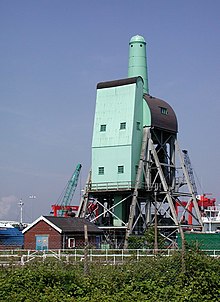Coal hoist
A coal hoist is a mechanical port handling system for emptying hard coal lighter in colliers (coal ships).
history
In the middle of the 19th century, the English engineer William H. Bartholomew developed a coal transport system for the Aire and Calder navigation, with which from 1863 to 1986 coal was carried through the newly opened Knottingley Canal to the mining sites in Stanley Ferry , South Yorkshire for about 50 kilometers distant Goole was transported. It initially consisted of the Tom Pudding Lighter, a rectangular transport container for around 40 tons of coal, which was moved in a group.
In order to save the unloading with a crane , the coal hoists called coal hoists were built soon afterwards , with which the individual transport containers in the port of Goole were tipped directly into the seagoing vessel. The individual Tom Puddings were swum in over a platform, pulled out of the water with the platform, lifted and tipped over in front of a chute from which the coal slipped down into the sea-going ship lying alongside. The coal light lifts were powered hydraulically.
Five of the coal hoists were operated in Goole alone , and similar facilities were later built in other coal ports on the British east coast. The coal hoists' operation in Goole ended in the mid-1970s. Four of the transshipment facilities were later demolished and scrapped, one is still preserved today and classified as a second-order technical monument.
swell
- Description of the coal hoists (English)
- Description of the Tom Pudding History (English)

